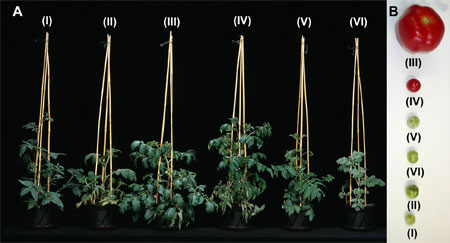From rxpgnews.com
DNA Fragments for Making Tomatoes Taste Better Identified
By Max Planck Society
Mar 27, 2006, 04:19
Tomatoes are a major nutrient for humans. In 2004, 120,000 tonnes of tomatoes were harvested worldwide - and every year this number increases. Numerous medical studies have shown the health value of tomatoes. Lycopen, the pigment that makes tomatoes red, can for example prevent heart disease. Tomatoes furthermore contain a lot of vitamins C and E, indispensable for human nourishment. But after centuries of cultivation for shape, colour, and other useful qualities, our cultured tomatoes today are of small genetic diversity, in comparison with wild types. This has affected the taste and health value of the fruits.
To cultivate tomato strains with particular characteristics, researchers have to increase the genetic diversity of cultured tomatoes. This can be done either by cross-breeding them with wild tomatoes, or changing their genetic make-up technologically. Scientists from the Max Planck Institute for Molecular Plant Physiology in Golm, and their Israeli colleagues at Hebrew University in Jerusalem, chose the second option. They investigated strains of tomatoes created from the crossing of cultured and wild types. Their goal was to identify the biochemical composition of fruits and determine which factors control their development. The German-Israeli research team used a method of analysis developed at the Max Planck Institute for Molecular Plant Physiology. The technique - a combination of mass spectrometry and gas chromatography - analyzes the composition of biological samples. It can be used to quickly and simultaneously look into a fruit�s amino acids, organic acids, sugar and vitamins.
Dr. Alisdair Fernie, head of the Institute�s "Central Metabolism" research group, discovered that there were 880 variations in the content composition of descendants produced by crossing cultured tomatoes and wild tomatoes. "On one hand, we measured higher amounts of essential amino acids and vitamins, on the other hand the fruits showed an altered combination of various sugars and organic acids," Fernie says. These contents have a great influence on the taste of tomatoes.
 |
| A) tomato plants and B) tomato fruits of the Solarum Lycopersicum complex, which are easily cross-bred with each other. Various wild tomatoes - (I) S. chmielewskii, (II) S. habrochaites, (IV) S. pimpinellifolium, (V) S. neorickii, (VI) S. pennellii - are all excellent for hybridisation with the cultured tomato (III) S. lycoperisicum. Image Courtesy: Max Planck Institute of Molecular Plant Physiology |
The scientists used molecular biological methods to identify parts of the tomato genomes responsible for biochemical changes. The researchers� findings could make it possible in the future to cross-breed wild tomatoes with cultured tomatoes in a targeted way to make them more nutritious.
All rights reserved by www.rxpgnews.com
